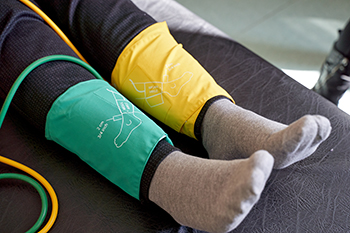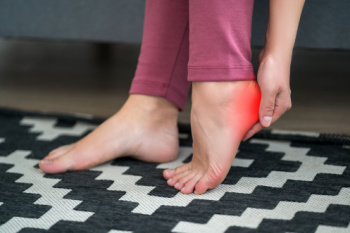
Orthotics play an essential role in alleviating various foot and lower limb conditions. When prescribing orthotics, several factors are considered, including biomechanical alignment, patient aesthetics, compliance, and joint stability. Biomechanical assessments evaluate gait patterns, foot structure, and joint range of motion to determine the most effective orthotic design. Aesthetics consideration involves ensuring that orthotics fit comfortably into the patient's shoes and lifestyle. Patient compliance is vital for long-term success, as orthotics must be worn consistently to achieve desired outcomes. Custom-made orthotics are preferred for their tailored fit and targeted support. They address specific biomechanical issues, providing support, stability, and alignment correction as needed. These orthotics are crafted based on precise measurements and molds of the patient's feet, ensuring optimal functionality and comfort. If you would like to learn how custom-made orthotics can improve your mobility and quality of life, it is suggested that you schedule an appointment with a podiatrist for an evaluation and further discussion.
If you are having discomfort in your feet and would like to try orthotics, contact Leonora Fihman, DPM from California. Our doctor can provide the care you need to keep you pain-free and on your feet.
What Are Orthotics?
Orthotics are inserts you can place into your shoes to help with a variety of foot problems such as flat feet or foot pain. Orthotics provide relief and comfort for minor foot and heel pain but can’t correct serious biomechanical problems in your feet.
Over-the-Counter Inserts
Orthotics come in a wide variety of over-the-counter inserts that are used to treat foot pain, heel pain, and minor problems. For example, arch supports can be inserted into your shoes to help correct overarched or flat feet, while gel insoles are often used because they provide comfort and relief from foot and heel pain by alleviating pressure.
Prescription Orthotics
If over-the-counter inserts don’t work for you or if you have a more severe foot concern, it is possible to have your podiatrist prescribe custom orthotics. These high-quality inserts are designed to treat problems such as abnormal motion, plantar fasciitis, and severe forms of heel pain. They can even be used to help patients suffering from diabetes by treating foot ulcers and painful calluses and are usually molded to your feet individually, which allows them to provide full support and comfort.
If you are experiencing minor to severe foot or heel pain, it’s recommended to speak with your podiatrist about the possibilities of using orthotics. A podiatrist can determine which type of orthotic is right for you and allow you to take the first steps towards being pain-free.
If you have any questions please contact our offices located in Encino and Brentwood, Los Angeles, CA . We offer the newest diagnostic and treatment technologies for all your foot and ankle needs.

Peripheral artery disease, or PAD, is a condition characterized by narrowing or blockage of the arteries, typically in the legs, due to the buildup of fatty deposits. This restricts blood flow to the limbs, affecting the feet and causing various symptoms. Those at risk include smokers, diabetic patients, individuals with high blood pressure or cholesterol, and those with a family history of cardiovascular disease. Symptoms may include leg pain, cramping, numbness, weakness, or coldness in the feet and legs, especially during physical activity. However, some people with PAD may not experience any symptoms, a condition known as asymptomatic PAD. A podiatrist evaluates PAD through a comprehensive consultation, which may include assessing symptoms, and medical history, and performing tests like ankle-brachial index measurements or Doppler ultrasound to determine blood flow. Treatment focuses on managing symptoms, improving circulation, and reducing the risk of complications through lifestyle changes, medications, or surgical interventions. If you suffer from foot symptoms of PAD, it is suggested that you schedule an appointment with a podiatrist for care.
Peripheral artery disease can pose a serious risk to your health. It can increase the risk of stroke and heart attack. If you have symptoms of peripheral artery disease, consult with Leonora Fihman, DPM from California. Our doctor will assess your condition and provide you with quality foot and ankle treatment.
Peripheral artery disease (PAD) is when arteries are constricted due to plaque (fatty deposits) build-up. This results in less blood flow to the legs and other extremities. The main cause of PAD is atherosclerosis, in which plaque builds up in the arteries.
Symptoms
Symptoms of PAD include:
It is important to note that a majority of individuals never show any symptoms of PAD.
Diagnosis
While PAD occurs in the legs and arteries, Podiatrists can diagnose PAD. Podiatrists utilize a test called an ankle-brachial index (ABI). An ABI test compares blood pressure in your arm to you ankle to see if any abnormality occurs. Ultrasound and imaging devices may also be used.
Treatment
Fortunately, lifestyle changes such as maintaining a healthy diet, exercising, managing cholesterol and blood sugar levels, and quitting smoking, can all treat PAD. Medications that prevent clots from occurring can be prescribed. Finally, in some cases, surgery may be recommended.
If you have any questions, please feel free to contact our offices located in Encino and Brentwood, Los Angeles, CA . We offer the newest diagnostic and treatment technologies for all your foot care needs.

Heel spurs occur in two main forms. One is called heel spur syndrome and the other is termed insertional Achilles tendinitis. Heel spur syndrome involves a bony growth at the bottom of the heel, often resulting from repetitive stress or strain on the foot. Symptoms include sharp pain upon standing or walking, particularly after periods of rest. Conversely, insertional Achilles tendinitis involves inflammation where the Achilles tendon connects to the heel bone. This condition commonly arises from overuse, tight calf muscles, or poor footwear, leading to pain and swelling at the back of the heel. Treatment for both conditions typically starts with conservative measures like rest, stretching, and orthotics. If you have pain that could signify one of these types of heel spurs, it is suggested that you schedule an appointment with a podiatrist who can provide corticosteroid injections or custom shoe inserts to alleviate discomfort. In severe cases, surgical options, such as heel spur removal or Achilles tendon repair, may be considered.
Heel spurs can be incredibly painful and sometimes may make you unable to participate in physical activities. To get medical care for your heel spurs, contact Leonora Fihman, DPM from California. Our doctor will do everything possible to treat your condition.
Heels Spurs
Heel spurs are formed by calcium deposits on the back of the foot where the heel is. This can also be caused by small fragments of bone breaking off one section of the foot, attaching onto the back of the foot. Heel spurs can also be bone growth on the back of the foot and may grow in the direction of the arch of the foot.
Older individuals usually suffer from heel spurs and pain sometimes intensifies with age. One of the main condition's spurs are related to is plantar fasciitis.
Pain
The pain associated with spurs is often because of weight placed on the feet. When someone is walking, their entire weight is concentrated on the feet. Bone spurs then have the tendency to affect other bones and tissues around the foot. As the pain continues, the feet will become tender and sensitive over time.
Treatments
There are many ways to treat heel spurs. If one is suffering from heel spurs in conjunction with pain, there are several methods for healing. Medication, surgery, and herbal care are some options.
If you have any questions feel free to contact our offices located in Encino and Brentwood, Los Angeles, CA . We offer the latest in diagnostic and treatment technology to meet your needs.
